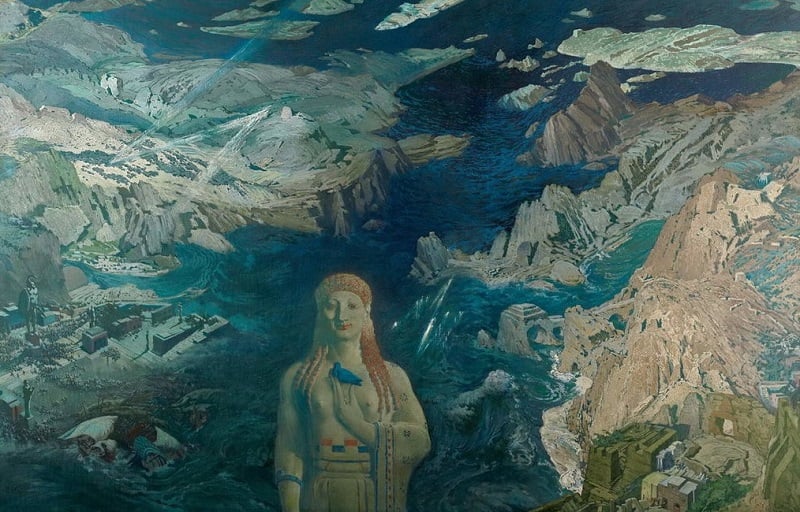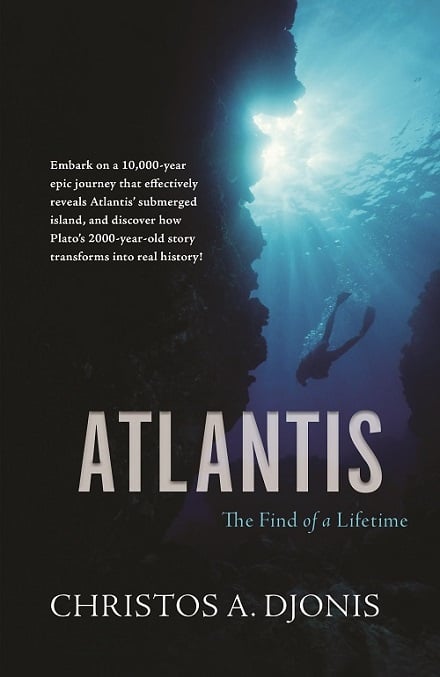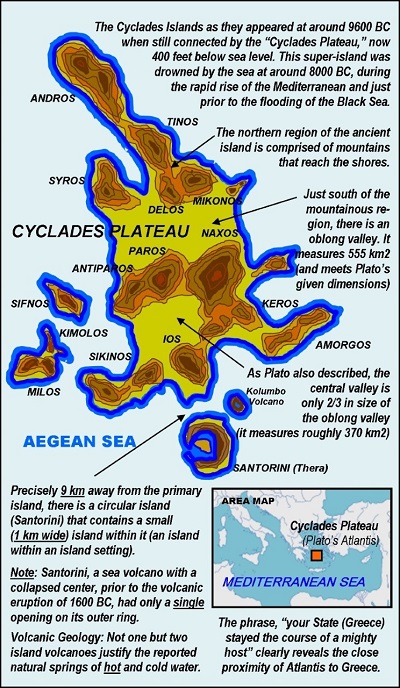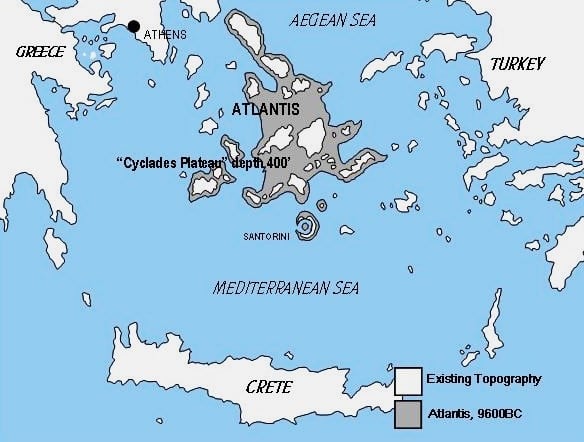
Has the Atlantis mystery finally been solved? After years of extensive research, in conjunction with new archeological evidence, and with the aid of satellite technology, Christos A. Djonis credibly reveals that Plato based his story of Atlantis on a real prehistoric setting, now beneath 400 feet of water.
Although most people around the world agree that the original Santorini hypothesis so far made the most compelling case where Plato’s Atlantis once was, unfortunately, there are two critical flaws with that theory, which have allowed critics over the years to maintain the story was just a myth.
The first problem is that the hypothesis entirely discards Plato’s given chronology of 9600 BC. Another more significant problem with the original theory is that the primary island of Atlantis, an island the size of Crete, one Plato said was supposed to be 9 kilometers away from the circular island within an island setting, is not around the Santorini backdrop of 1600 BC.
As we all know, a genuine discovery requires that all elements of a physical description are present, and all are in the given order. In this case, if any of the clues given to us by Plato is missing, the elements are not arranged in the correct order, or the chronology does not coincide with Plato’s given chronology, then all we have is speculation.
The book ATLANTIS The Find of a Lifetime embarks on a chronicled 10,000-year journey that effectively reveals Atlantis’s submerged island and demonstrates how Plato’s 2400-year-old story corresponds to real history.

Not only do the physical characteristics of the proposed location, along with the given chronology, match Plato’s description, but all the elements are precisely in the exact order as Plato depicted in his story.
Unlike previous studies, the book’s 6-year research began by purposely adhering to the correct chronology of 9600 BC, as without the given chronology, there could not be a perfect match. Incidentally, starting with the correct chronology was the key to solving this puzzle.
Atlantis under 400 feet of water
As various oceanographic studies pointed out that the oceans and the Mediterranean were then lower by 400 feet, it was estimated that if the lost island of Atlantis was ever a real place, it had to be under 400 feet of water.
Likewise, as the island of Santorini was already a good candidate (it is worth pointing out that before the 1646 BC eruption, the island had a single opening on its outer ring, just as Plato depicted), the area around the Aegean Sea ultimately became the primary target.
Following that logic, discovered that various oceanographic studies of the Mediterranean (see textbook “Coastal and Marine Geospatial Technologies”) revealed that Santorini, circa 9600 BC, was nearly connected with another prehistoric super-island.

This massive island, almost the size of Crete, and the prehistoric Santorini lying 9 kilometers away from the primary island (an island within an island setting where according to Plato, the crown city of Atlantis once stood) perfectly matches Plato’s description.
The vast Cycladic plateau
As it turns out, the Cyclades Islands were once connected by a vast plateau now 400 feet underwater (the Cyclades Plateau) and the Cyclades, as we know them today, were mountaintops of the prehistoric super-island that covered an area of 5282 km2.
As also pointed out in the Coastal and Marine Geospatial Technologies, if Atlantis was ever real, “its disappearance may not be owed to tectonic reasons (sudden submergence) but to eustatic ones (marine transgression). Indeed, just as Plato pointed out that Atlantis’s end came at a “later time” (at some point in time) and after a series of prolonged “portentous earthquakes and floods” (floods in plural).
Following Plato’s description of the end, it reads as if strong earthquakes and frequent floods (associated with the rise of the oceans) began to take a toll on the island for decades.
At the end of the last Ice Age, at around 8,000 BC, just before the flooding of the Black Sea(1), when the melting of the glaciers reached a climax, and the ocean levels began to rise more aggressively, the sea level in the Mediterranean abruptly(2) rose high enough to flood the valleys and lower elevations of Atlantis.

Sudden sea level rise claimed Atlantis
Sudden sea level rise was the “flood” that claimed the island. The flat terrain of the entire island became “impassable and impenetrable,” and as Plato explained, “this was caused by the subsidence of the island.”
Of course, knowing nothing of the natural forces at play, Plato misinterpreted the sea’s rise and called it the “gradual sinking” of the island. However, although Plato misunderstood what really occurred, he described a natural catastrophe that ultimately erased our early history.
As for the occupants of that prehistoric island, recent DNA studies by the University of Washington and others concluded that after the sea level in the Mediterranean began to rise, to escape the inundation, some of those people migrated as far as the island of Crete(3) (reestablishing themselves as the Minoan(4) civilization) while others migrated to the nearby Peloponnese (emerging soon after as the Myceneans).
Those remaining behind on the mountaintops of the prehistoric island (now small islets6) eventually regrouped and are known today as the Aegean civilization. As we know, of course, the Minoans ultimately recaptured Santorini and the Aegean islands, and today most historians presume that the Aegean and Minoan civilizations are one and the same.
DNA studies
DNA studies though (and as similarly reported by Greek Reporter on 9/18/21) point out that the extreme similarities between the Minoans and the Myceneans in art, in architecture, in their customs & traditions were most likely heritable connections and not influences as previously historians thought).
Finally, more recent DNA studies also pointed out that the mysterious Sea People (the boogeyman of the Bronze Age), who appeared in the Mediterranean sometime after the Santorini volcanic eruption of 1646 BC, were actually of Minoan ancestry. Ironically enough though, after these people began settling in Cyprus and ultimately along the shores of modern-day Palestine, historians renamed them Philistines (a culture they thought originated in Cyprus).
Plato based his story on a real setting
In conclusion, as it seems, Plato did with Atlantis just as Homer did with Troy a few hundred years earlier. He based his story of Atlantis on a real setting and a prehistoric civilization known to ancient Greeks, one that Plato decided to use to best communicate his philosophical story (divine vs. human, ideal societies vs. corrupt).
Plato’s knowledge perhaps that the Minoans were the descendants of those he referred to as Atlanteans have allowed him to introduce these people from their very early beginnings at around 9,600 BC, and through their ultimate demise by the mainland Greeks at about 1,500 BC.
He depicted the super-island of the Cyclades Plateau (or the island of Atlantis, if you will) before it was drowned by the rising seas. He described the Atlanteans’ aggressive character toward their Mediterranean neighbors and others. In regard to everyday details and their way of life, Plato chose to use aspects from a much later time in their history, the “Minoan” era(7) (thus the confusion today in the matter).
Finally, he correctly reported their incredible skills and unwitting genetic contribution to history by crossing the Atlantic “via island-hopping”. (See genetic migration studies of haplogroup X(5), which shows how this Mediterranean gene managed to travel island by island and established itself around the Great Lakes more than 12,000 years ago).
To put most other theories to rest, when carefully reading Plato’s text, it becomes clear that he talked about a prehistoric place within the Mediterranean, a land of skillful navigators capable of traveling via island hopping to another continent across from the Strait of Gibraltar.
DNA studies today also conclusively confirm that an ancient Mediterranean civilization reached North America during the chronology given to us by Plato.
On the flipside, no known American haplogroup (A, B, C, or D) was ever found in prehistoric Europe to justify an eastward advance from the west. This further shows that the notion that Atlantis was somewhere within the Atlantic and it was advancing towards those within the Mediterranean is a misconception based on false interpretations of Plato’s text.
Notes:
(1) In a 1997 study, Ryan and Pitman theorized that the flooding of the Black Sea happened at around 5600 BC. Unfortunately for the Ryan and Pitman team another later study was conducted and reported differently. In 2005, a research project under UNESCO’s sponsorship was conducted by the International Union of Geological Sciences and a Ukrainian and Russian scientific team that included Valentina Yanko-Hoback. The latest study contradicted the severity of the flood and the chronological time of the event. They published in 2009 that the Black Sea flood was more of a gradual event and less catastrophic to human life than previously thought. Most importantly, it was determined that the incident took place earlier chronologically and closer to 8,000 BC.
Note: If past periodic Ice Ages and floods, over millions of years, did not manage to raise sea levels by 400 feet and add salinity into the freshwater of the Black Sea (a freshwater lake until that point), then undoubtedly the last global flood around 8,000 BC must have been the “greatest” flood of all time. This was what destroyed Plato’s prehistoric Atlantis and erased the evidence of our early history around the planet.
(2) The sudden global sea-level rise by as much as 9 feet was most likely due to the collapse of Lake Agassiz into the North Atlantic. Lake Agassiz was a glacial lake in North America roughly the size of the Black Sea (which held 440,000 km2 of fresh water, more than all the lakes in the world today). Some today believe that a meteor impact in North America during that time was the cause behind Lake Agassiz’s collapse, while others think the collapse occurred naturally. Either way, that incident was also responsible for the 8.2 kilo-year event that followed, a mini-Ice Age that lasted for 400 years.
(3) Those who question whether primitive humans could have sailed to Crete during our prehistory should read a 2010 article by National Geographic with the title “Primitive Humans Conquered Sea, Surprising Study Suggests.” The study points out that prehistoric humans were able to sail to the island of Crete tens of thousands of years earlier than previously thought.
(4) The Minoan name is just a nickname given to that civilization by Sir Arthur Evans when he found their ruins on the island of Crete. No one to this day knows for sure what was their true name. The Egyptians who introduced the story and Plato though, could have very well known that the Minoans and Atlanteans were in fact the same people (if so, was a clarification to future generations by Plato necessary in order to present his story? Not really.)
(5) Although historians initially theorized that haplogroup X migrated to the Great Lakes of North America via the Bering Strait, heavy traces of haplogroup X around Gibraltar, England, Scotland, Faroe Islands, Iceland, and ultimately in Newfoundland point to a transatlantic migration instead. No haplogroup X traces were ever found in the opposite direction through the Bering Strait. A 1998 article in the PMC Journal (US National Library of Medicine National Institutes of Health) with the title “mtDNA haplogroup X: An ancient link between Europe/Western Asia and North America?” concluded that “some Native American founders were of Caucasian ancestry.” Another 2015 article in PaleoAmerica (a journal of early human migration and dispersal), titled “Does Mitochondrial Haplogroup X Indicate Ancient Trans-Atlantic Migration to the Americas? A Critical Re-Evaluation,” pointed out that the two lineages of haplogroup X2 found in North America and the Altai Republic are entirely different. This discovery allowed those behind the study to conclude that X2 and X2a in North America are evidence of not just one but two distinct trans-Atlantic migrations there before European contact. While the first migration took place during our prehistory, as it appears, the second migration could have occurred at around 4000 BC. A 2019 article by BBC with the title “Stonehenge: DNA Reveals Origin of Builders” pointed out that “DNA reveals that Neolithic Britons were largely descended from (eastern Mediterranean) groups who took the Mediterranean route, either hugging the coast or hopping from island-to-island on boats around 4000 BC.”
(6) Plato ultimately describes the particular region and explains that once the flood cycle finally ended, the island’s mountain tops remained above water and formed small islands. Poetically, he compared these remaining islets to the “bones of the wasted body” of the “country” that once was there. “The consequence is, that in comparison of what then was, there are remaining in small islets only the bones of the wasted body, as they may be called, all the richer and softer parts of the soil having fallen away, and the mere skeleton of the country being left.”
His description did not end there, however. He went even further and dramatically described the environmental transformation of the Aegean between 9000 BC and his own time—nearly seven millennia later. He explained that the heavily forested mountains, which once supplied timber of sufficient size to cover even the largest houses, became small islets that could barely provide “sustenance to bees.” This is another vital piece of information where Plato perfectly depicts the total transformation of the region and explains how the once large, green islands of the Aegean, from ten millennia ago, ultimately became the small, dry islands we know today.
(7) If Plato was crafting an ideological story around a real setting and a prehistoric civilization that managed to endure into the Bronze Age, one the Greeks ultimately defeated, then in order to successfully communicate some of his philosophical ideas (divine vs. human, ideal societies vs. corrupt), he needed details that his Greek audience would be more familiar with (Greek names, Greek gods, orichalcum, etc.). Could otherwise his ideological story appeal to his audience if they could not connect or relate to it?


